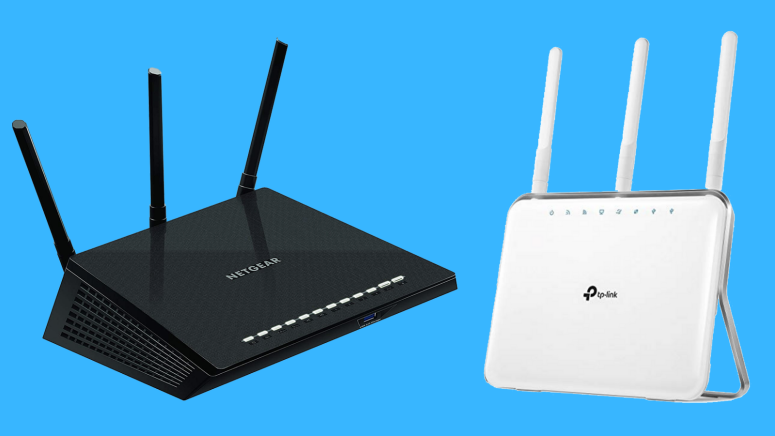
15 Best Routers Under $100 in 2020 For Entertainment and Productivity
Routers are an integral part of any PC setup, especially when you need to connect multiple devices. Often, our needs require a fairly capable router that can support high speeds but does not cost a bomb. Routers under $100 range are perfectly capable of addressing most home and office needs.
Often, you may need a capable router that caters to home entertainment and some productivity is thrown in. Hence you might not need advanced features such as packet prioritization and such but many OEMs do offer some added niceties in their software. The router variants in this budget are not as flashy as some of the gaming routers but offer strong performance, good coverage, and most importantly, value for money.
In this price range, the number of wireless bands is usually restricted to two — 2.4 GHz and 5 GHz so the maximum throughput is usually around the 1.2 Gbps to 1.9 Gbps range. Also, the software interface is usually well laid out and user-friendly but some of the more advanced scheduling features might not be available. However, most routers in this price range allow flashing custom DD-WRT firmware so adding new features should not be much of a problem.
For this article, several factors were considered for narrowing down the available options such as the number of bands that the router supports, the combined data transfer rate across all bands, connectivity options, software UI, etc.
So, with that information, here are the 15 best routers under $100 in 2020.
1. ASUS Dual-Band AC1300
The ASUS Dual-Band AC1300 is for those who prefer to have a router that can take on most networking needs for a small family. With the availability of both 2.4 GHz and 5 GHz bands, you can have a mix of long-range and high bandwidth within the same router. The router comes with MU-MIMO and Beamforming abilities, which add to its coverage and signal strength.
The router allows you to utilize the maximum possible bandwidth offered by your ISP and the Ethernet ports support full Gigabit LAN connections. The interface is easy to use yet offers all capabilities that are generally only found in custom firmware. You can also use it as a repeater if needed. However, setting up IPv6 configurations might need some tinkering around.
- Pros: Dual-band; ASUS apps; quad-core CPU
- Cons: IPv6 configuration can seem a bit tedious.
2. NETGEAR R6700 Nighthawk
The NETGEAR R6700 Nighthawk offers immense value for those who need the extra power for streaming and multimedia without breaking the bank. It supports combined speeds up to 1.7 Gbps, which should be more than enough for catering to multiple devices. The three antennas provide enough coverage for a medium-sized apartment. It does not come with fancy beamforming abilities but unless you have many obstructive objects in the signal path, it should not be much of a concern.
While the included software offers advanced features such as QoS scheduling, those looking at a more granular control will be disappointed. But for those looking to connect their home media server, VPN, PCs, and smart TVs all at the same time, the NETGEAR R6700 is one the best budget routers available.
- Pros: Dual-band; QoS; Gigabit speeds
- Cons: UI is not feature-rich
3. TP-Link Archer A7
The TP-Link Archer A7 is one of the best routers under $100 and is ideal for both home and office use. With three active antennas, the router promises coverage of 2,500 square feet, which should cover most moderately sized homes. You can also simply enable and disable guest connections with just your voice as it is compatible with Amazon Alexa.
Setting up the Archer A7 is very easy and hassle-free. Although it advertises OpenVPN compatibility, configuring that might be a bit complicated. DD-WRT support is not available but the included firmware is more than capable.
- Pros: Dual-band; TP-Link Tether App; Amazon Alexa compatible
- Cons: Complicated OpenVPN configuration
4. TP-Link Archer C9
The TP-Link Archer C9 sports a slim design that can complement any decor. It offers a combined throughput of 1.9 Gbps across the 2.4 and 5 GHz bands, which should provide enough bandwidth for connecting most peripherals including game consoles. The onboard 1 GHz CPU prevents any operating bottlenecks and the router also comes with beamforming capability, which is a rare sight in this price.
The Archer C9 offers great signal strength and coverage and is very easy to set up. There have been no real problems reported except for some issues with the 5 GHz band but nothing that a software reset can't fix.
- Pros: Dual-band; Suitable for gaming; 1 GHz dual-core CPU
- Cons: 5 GHz band reported to have connectivity issues
5. Linksys EA6350
The Linksys EA6350 is a very good option for those looking at an all-purpose router under $100. Its dual-band support can yield a maximum throughput of 1.2 Gbps and the included USB 3.0 port allows fast transfer of data on storage devices to other devices in the network. Unlike many routers in this price, the EA6350 has only a dual antenna set up but they have adequate power and their positioning can be adjusted to maximize coverage in a small apartment.
The EA6350 also features beamforming, which is not a common feature in this price. While setting up the router is a fairly hassle-free process, there have been some reports of having an unstable connection in the 5 GHz process. However, recent updates seemed to have fixed this. You can also disable the MU-MIMO function if you don't need it to increase connection stability.
- Pros: Dual-band; beamforming; MU-MIMO function
- Cons: Only 2 antennas
6. ASUS RT-AC66U
The ASUS RT-AC66U is a feature-packed router just shy of $100. The router features a 1 GHz dual-core CPU for eliminating bottlenecks while simultaneously using the network and USB 3.0 port. The ASUS Router app allows controlling most parameters without having to resort to custom firmware. It also comes with AiProtection powered by Trend Micro for preventing DDoS attacks.
This being an AiMesh capable router, you can connect multiple ASUS routers to increase the throughput. Perhaps, the only limitation with this router is that you cannot tether from the USB. If you really need that functionality, the only option would be to resort to custom firmware. That said, if you need a high bandwidth router that has a wide coverage area, the ASUS RT-AC66U should top your list.
- Pros: Dual-band; ASUS apps; AiMesh compatible
- Cons: No USB tethering
7. Medialink MLWR-AC1200
The Medialink MLWR-AC1200 undercuts other popular routers from ASUS and NETGEAR by a fair margin making it a compelling purchase option. All essentials for basic home networking are covered and the router also can double-up as a range extender. It can even offer secure guest access without affecting your network's security. As an added bonus, if the router's lights are bothering you at night you can turn them off altogether.
Performance-wise, the router performs just as well as the more expensive offerings from other brands. Medialink touts its US-based service as an advantage and it shows in the customer satisfaction. Connection drops are almost non-existent and the time taken to resolve complaints, if any, is extremely quick. In short, you cannot go wrong with this.
- Pros: Dual-band; Range extender; Beamforming; Router light control; Prompt service
- Cons: None as such
8. NETGEAR N750
The NETGEAR N750 is a high-performing router for less than $100. It may not boast of high speeds of some of the others in this series but it hardly makes a difference if your ISP speeds are less than 100 Mbps. It still features dual-band AC wireless so connecting to the 5 GHz band shouldn't pose any problems. The range also is pretty decent for small to medium-sized homes.
While the router is pretty capable for the price, do take note about NETGEAR's warranty policies before committing to a purchase. Also, the firmware might not be up to everyone's taste so if you're comfortable with installing custom firmware, this router perfectly fits the bill.
- Pros: Dual-band; ReadySHARE for files and printers.
- Cons: Warranty policy needs to be verified; Not a particularly intuitive UI
9. Securifi Almond
If you are looking for a no-frills cheap router that is one of the easiest to set up, give the Securifi Almond a look. The Almond sports a touchscreen that makes it easy to configure many aspects of the router without having to actually log in to the web interface. It also acts as a universal range extender compatible with most routers from leading brands. The Almond can also control smart devices via Amazon Alexa voice commands.
The Almond would have been the ideal home router if it had support for the 5 GHz band as well. But if you don't have such speeds in your connection, then the single-band should not pose many issues. A good feature we liked is that you can simply connect your home security or automation system to this router and have it deliver notifications straight to your smartphone. The tech support is also praiseworthy. However, ensure that the router is placed in the appropriate location for maximum coverage as it does not support beamforming.
- Pros: Easy setup; Touchscreen; Amazon Alexa compatible
- Cons: Single-band; No beamforming
10. Motorola MR1900
The Motorola MR1900 is a very viable option under $100 due to its dual-band AC wireless support and Gigabit transfer speeds. The MR1900 has internal antennas for each of its 6 Wi-Fi channels. The router supports beamforming for enhanced signal delivery to multiple devices. The presence of a USB 3.0 port ensures that you can connect storage devices to the router and share files between devices.
The performance of the router is on par with any other router in this price range. The setup process is easy and the range is great. However, there are some reported issues of IPv6 configuration. Unless your ISP is insistent on using IPv6, this is an aspect that you can still get by with. For less than $100, it is hard not to recommend this router.
- Pros: Dual-band; Beamforming support; Great performance
- Cons: IPv6 configuration can have issues
11. NETGEAR R6230
The NETGEAR R6230 is an affordable choice to cover your basic internet needs with some additional features thrown in. The R6230 can provide a total throughput of 1200 Gbps across its dual bands and comes with an 880 MHz and 128 MB RAM for a stutter-free operation. The router also offers advanced QoS and IPv6 support that not many offers at this price range. You also get a total of five LAN ports with one being used for the WAN and four others to connect your devices. There is a single USB 2.0 port that can connect to storage devices and network printers. We wish NETGEAR had offered a USB 3.0 port for faster speeds.
Almost all functions of the router can be accessed via the Nighthawk app on smartphones and tablets. You can also use the web UI for additional configuration options. However, many users report that some of the options are not accessible and NETGEAR charges to configure the same. We recommend clarifying these and other warranty information with NETGEAR before purchase. Overall, the NETGEAR R6230 will not disappoint if you are looking for a good router under $100 that does not cut too many corners.
- Pros: Good performance and range
- Cons: Some configuration options are not readily accessible
12. Motorola MR1700
The Motorola MR1700 is a sleek, premium look router that is easy on the wallet. The MR1700 supports six antennas that are adjustable so you can get a good range throughout the room. Of the six antennas, four belong to the 2.4 GHz band while two are for the 5 GHz band. The router supports a peak theoretical transfer rate of 1.7 Gbps, which should suffice for most use cases. The MR1700 offers a total of five Gigabit Ethernet ports with four of them used for connecting client devices. There is no USB port of any kind so those looking to hook up storage devices and network printers will have to look elsewhere. Also, there is only one indicator LED on the front so it is difficult to know the status with the single light.
Performance-wise, the MR1700 offers decent speeds and range. You also get good parental controls and the ability to set up a guest network. Using the built-in web UI is fairly easy and Motorola offers regular firmware updates as well. You can also flash DD-WRT firmware but this voids the warranty so we'd recommend exercising due caution. All said and done, you cannot go wrong with the Motorola MR1700 if all you are looking for is basic functionality. The lack of a USB port and an extensive array of status indicators are a few things to be aware of before purchase.
- Pros: Good speeds; Easy to setup
- Cons: No USB port; Only one status indicator LED
13. TP-Link RE220
If you are looking for a capable range extender under $100, the TP-Link RE220 deserves a consideration. At first sight, the RE220 resembles an air freshener and is very compact. It houses three internal antennas, which provide enough signal strength to cover a 3,200 sq.ft. range. You also get a single Ethernet port to connect any wired client you may have. The RE220 has a status light to check if you are too far away from the main router so you'll know if the location is ideal for a good signal. The RE220 is a dual-band range extender and uses both the bands by default. However, the 5 GHz band is also shared for backhauling, which can lead to reduced speeds. You have the option of dedicating a band exclusively for backhauling, though.
The TP-Link RE220 offers a fair amount of configuration features in the app and web UI. The speeds are good and are directly dependent on the range. You can get better performance at a farther distance than near a router. There is no band steering option so you'll have to manually change the bands according to your device's needs. That being said, you are still getting a lot of functionality at this price. You can also pair multiple RE220s to form a mesh network. Do remember that this range extender is best suited for mid-range networks and not for really high-end ones.
- Pros: Good looks and performance; Good range
- Cons: No USB port; Dedicated backhaul channel needs to be manually configured
14. Google Wi-Fi
If you are looking for a good mesh networking system that also works as a standalone router, take a look at Google Wi-Fi. Google Wi-Fi stands apart from the other routers when it comes to simplicity and ease of use. Power users will be likely disappointed with the lack of extra customization options but for most home users, this is one of the simplest routers to set up. A single Google Wi-Fi node can be had just short of $100 and can cover up to 1,500 sq.ft. You can add more nodes to enhance the coverage, but the single node should suffice for most homes.
Setting up Google Wi-Fi is very easy and all you need is the iOS or Android app. A lot of functionality such as band switching, beamforming, etc. is done automatically behind the scenes so you won't be getting to play around with those. However, you do get good networking monitoring and speed test functions along with the ability to test the connection speed amongst the nodes themselves. Performance is right up there with the best routers in the market and streaming 4K videos or playing online multiplayer games should pose no issues. The current speeds of Google Wi-Fi are capped at 1.2 Gbps. Hopefully, faster options will also be made available soon.
- Pros: Easiest to setup; Smartphone app; Network monitoring and prioritization
- Cons: Not many configuration options; Speed limited to 1.2 Gbps
15. Wise Tiger Wireless Router
If you're on a very tight budget, the Wise Tiger wireless router could be an option to consider. It is a very economical dual-band router that gets the basics right. The router supports up to 300 Mbps on the 2.4 GHz channel and up to 866 Mbps on 5 GHz. The Wise Tiger can be used as both a standalone router and as a wireless extender as it supports the WISP protocol. Setting up this router is fairly easy and pros also get to customize a lot of hardware settings. There are 5 Gigabit Ethernet ports at the back but no USB. The provided antennas offer a good range and can be adjusted in any direction.
The performance of the Wise Tiger is excellent for the price. Although there are some reports of the router failing, the majority of the customers seem to be satisfied with what is being offered for the price. The best part is that even at this low price, you get a 2-year warranty and a product replacement guarantee if the performance is not up to expectation.
- Pros: Very affordable; Good range and speeds; Can be used as a range extender
- Cons: No USB ports.
Dear readers, that would be all for our list of the best routers under $100 to consider buying in 2020. If you have additional questions, don’t hesitate to post a comment below. We will do our best to provide a timely response.
Finally, we’d like to ask you to share this article online. Also, don’t forget to follow us on Facebook and Twitter. Thanks!












